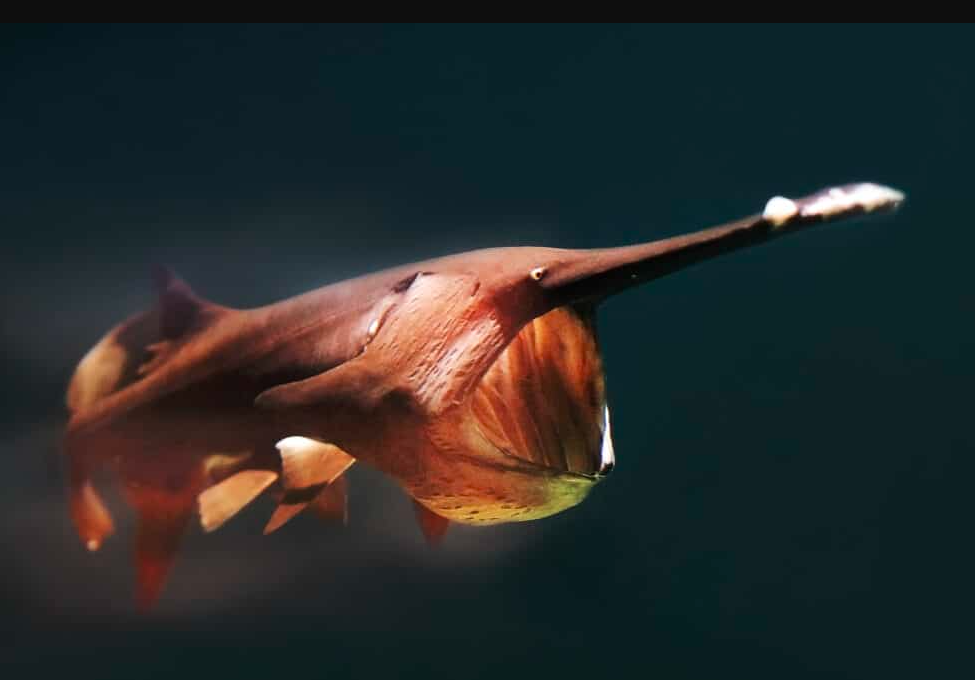The American Paddlefish (Polyodon spathula) is one of North America’s most fascinating and ancient freshwater fish species. Often referred to as a “living fossil,” this prehistoric fish has remained relatively unchanged for millions of years. Recognized by its distinctive elongated snout, or “rostrum,” the paddlefish is a unique and important species in aquatic ecosystems. This article explores everything you need to know about the American Paddlefish, including its history, physical characteristics, habitat, diet, reproduction, conservation status, and human interactions.
History and Evolution
The American Paddlefish belongs to the family Polyodontidae, which dates back over 300 million years. This makes the species one of the oldest surviving fish, predating even the dinosaurs. Fossil evidence suggests that paddlefish ancestors once lived in oceans and freshwater systems across the world, but today, only two species remain: the American Paddlefish and the Chinese Paddlefish (Psephurus gladius), the latter of which was declared extinct in 2020.
Physical Characteristics
One of the most distinguishing features of the American Paddlefish is its long, flat, paddle-shaped snout, which can make up nearly one-third of its total body length. This unique structure is highly sensitive and packed with electroreceptors that help the fish detect plankton and other tiny organisms in murky waters.
Key Physical Traits:
- Size: Adult paddlefish can grow up to 7 feet long and weigh between 60 and 100 pounds, though some individuals have been recorded at over 200 pounds.
- Body Structure: They have a smooth, scaleless body with a cartilaginous skeleton similar to that of sharks.
- Coloration: Typically bluish-gray with a white underbelly.
- Mouth and Teeth: Paddlefish lack traditional teeth in adulthood and instead rely on filter feeding to consume plankton.
- Lifespan: They have a long lifespan, often living between 30 and 50 years in the wild.
Habitat and Distribution
American Paddlefish are primarily found in the Mississippi River Basin, including rivers, lakes, and reservoirs across the central and southeastern United States. They thrive in slow-moving freshwater environments with abundant plankton populations.
Primary Habitats:
- Mississippi River and Tributaries – The largest natural habitat for paddlefish.
- Missouri, Ohio, and Arkansas Rivers – Key waterways supporting paddlefish populations.
- Lakes and Reservoirs – Paddlefish have been successfully introduced into several artificial water bodies for conservation and fishing purposes.
Diet and Feeding Behavior
Unlike many large fish species, paddlefish are filter feeders, meaning they consume microscopic plankton rather than hunting larger prey.
How They Feed:
- They swim with their large mouths open, filtering plankton through specialized gill rakers.
- The electroreceptors on their rostrum help detect plankton-rich waters.
- Their diet consists mainly of zooplankton, but they also consume small aquatic insects and crustaceans.
Reproduction and Lifecycle
American Paddlefish have a unique and complex reproductive cycle that depends on environmental conditions.
Key Reproductive Traits:
- Spawning Season: Typically occurs in the spring when water temperatures range between 50-60°F.
- Migration: Paddlefish migrate upstream to gravel-bottomed areas for spawning.
- Egg Production: Females lay thousands to millions of eggs, which adhere to rocks and hatch within a week.
- Growth Rate: Juveniles grow rapidly, reaching several feet in length within a few years.
- Maturity: Paddlefish take years to reach reproductive maturity; females may not spawn until they are 10-12 years old.
Conservation Status and Threats
While the American Paddlefish is not yet classified as endangered, it faces several significant threats that have led to population declines in some regions.
Major Threats:
- Habitat Destruction – Dam construction, water pollution, and river modifications disrupt natural migration and spawning.
- Overfishing – Due to their valuable roe (used for caviar), paddlefish populations have been impacted by commercial and illegal fishing.
- Climate Change – Altered water temperatures and flow patterns affect spawning behavior.
- Invasive Species – Competition with non-native species has reduced food availability in some areas.
Conservation Efforts:
- Fishing Regulations: Many states enforce strict size and catch limits to protect populations.
- Habitat Restoration: Efforts to improve river health and remove barriers to migration are underway.
- Stocking Programs: Hatcheries breed and release paddlefish to bolster wild populations.
Human Interaction and Economic Importance
Paddlefish play an important role in the fishing industry and are sought after for both sport and commercial purposes.
Fishing for Paddlefish:
- Sport Fishing: Paddlefish are popular among anglers, with snagging being the most common method due to their filter-feeding habits.
- Commercial Fishing: Primarily driven by demand for paddlefish caviar, which is considered an alternative to sturgeon caviar.
Role in Research and Aquaculture:
- Scientists study paddlefish to better understand ancient fish evolution and cartilage-based skeletal structures.
- Some fish farms raise paddlefish for meat and caviar production under controlled conditions.
Interesting Facts About the American Paddlefish
- Ancient Lineage – Paddlefish have existed for over 300 million years, making them older than dinosaurs.
- No Teeth as Adults – While young paddlefish have small teeth, adults rely entirely on filter feeding.
- Electrosensory Capabilities – Their rostrum detects electrical signals from plankton in the water.
- Longest Freshwater Fish in North America – They can grow over 7 feet long.
- One of Two Surviving Species – The Chinese Paddlefish, their only other relative, was declared extinct in 2020.
Conclusion
The American Paddlefish is a remarkable species with a long evolutionary history and vital ecological role. While they face challenges due to habitat loss and overfishing, conservation efforts continue to help sustain their populations. Whether appreciated for their unique appearance, sport fishing appeal, or scientific significance, paddlefish remain one of North America’s most fascinating freshwater fish.
